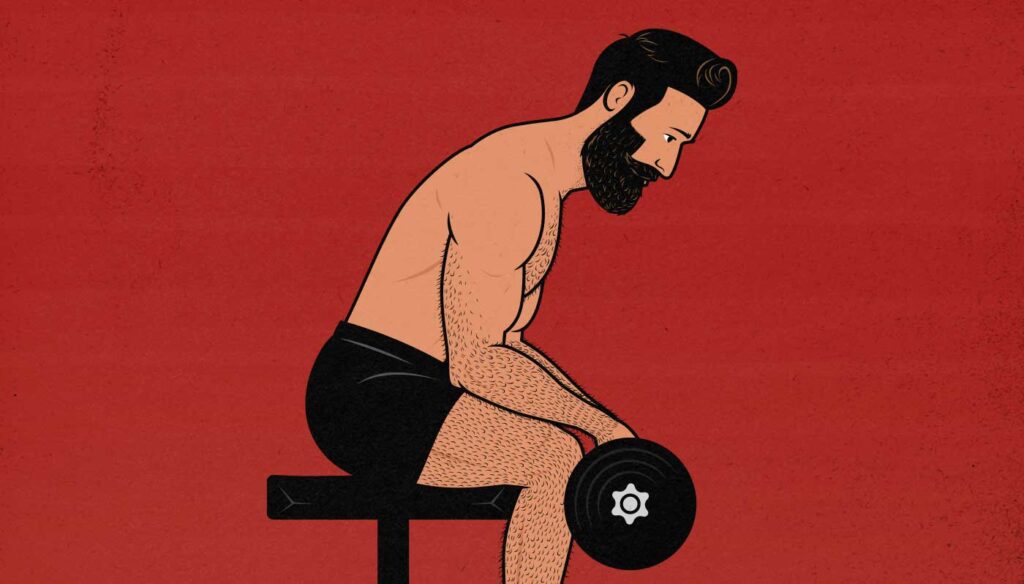
The 3 Best Exercises for Building Bigger Forearms
Forearms are one of those extremities that only extremists remember to train. The average lifter assumes that including some barbell rowing, strapless deadlifting, and weighted chin-ups in their workout routines will be enough to build bigger forearms, and although that can certainly help, the results are often underwhelming, especially for those with naturally thinner wrists. These are great exercises, but they aren’t great forearm exercises.
Your grip muscles are in your forearms, yes, but they’re fairly small, and making them stronger won’t make your forearms much bigger. And barbell rowing will bulk up your brachioradialis muscles, which are in your forearms. Those are beefier muscles, and they can definitely make your forearms look bigger, but they’re unlikely to be a limiting factor when you’re rowing, especially if you’re focusing on pulling with your upper back muscles, and especially if you’re using lifting straps. And so, again, your forearms might not grow all that much bigger.
Plus, even if you strengthen your grip and build bigger brachioradialis muscles, you’re still neglecting the vast majority of the muscles in your forearms—the forearm flexors and extensors. And so your forearms may stay fairly thin until you start doing dedicated forearm exercises.
So let’s talk about how to train your forearms, the best forearm exercises, and how to make the best forearm workout.
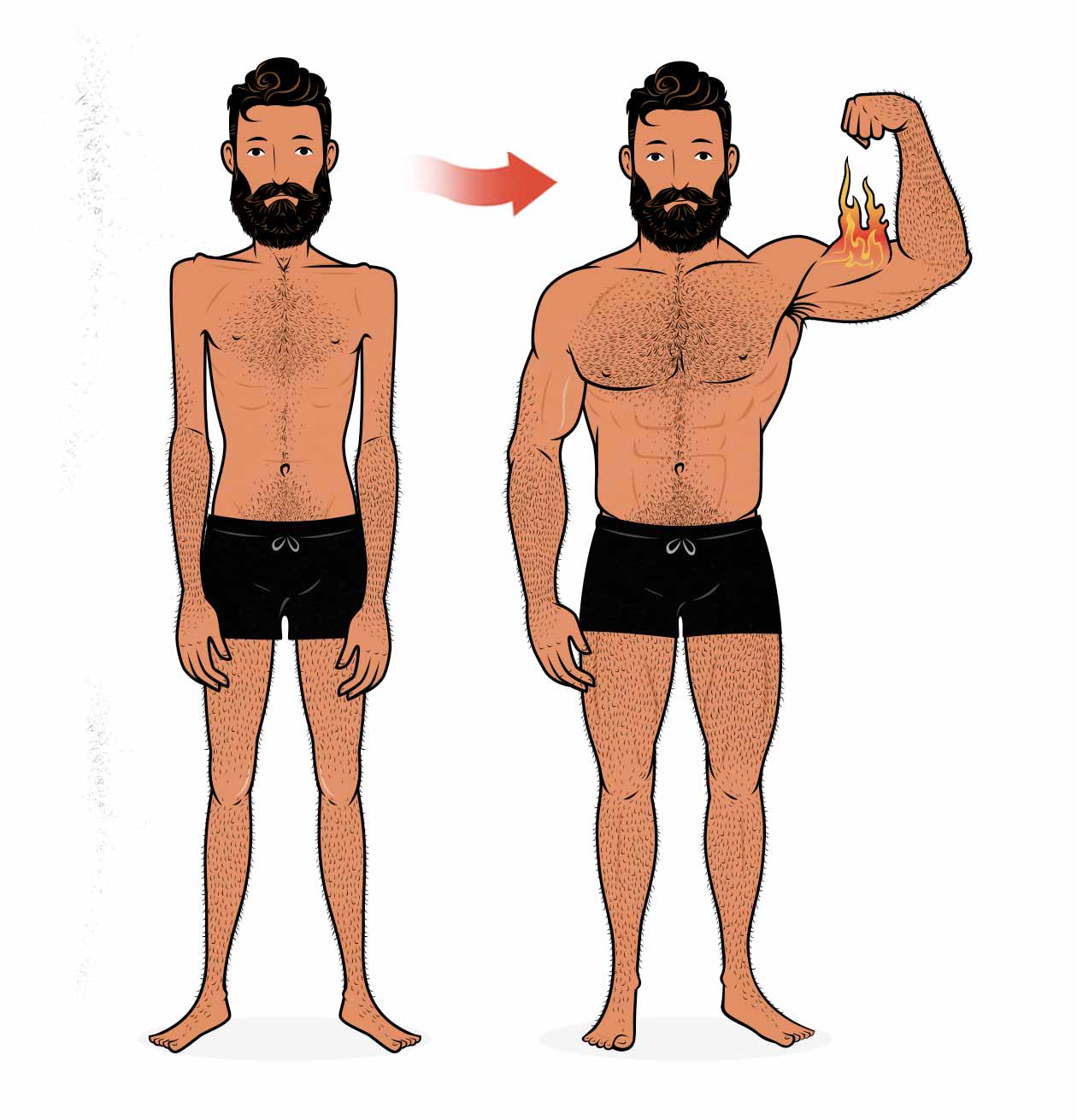
Introduction
Before we get into the nitty gritty of building bigger forearms, we should put forearm training into perspective. Almost every lift that we do in the gym, especially if we’re using using dumbbells or barbells, is limited by how much weight we can hold in our hands. And even with a simple lift like the biceps curl, we need to have the grip strength to hold the dumbbell in our hands and the forearm strength to keep our wrists from bending.
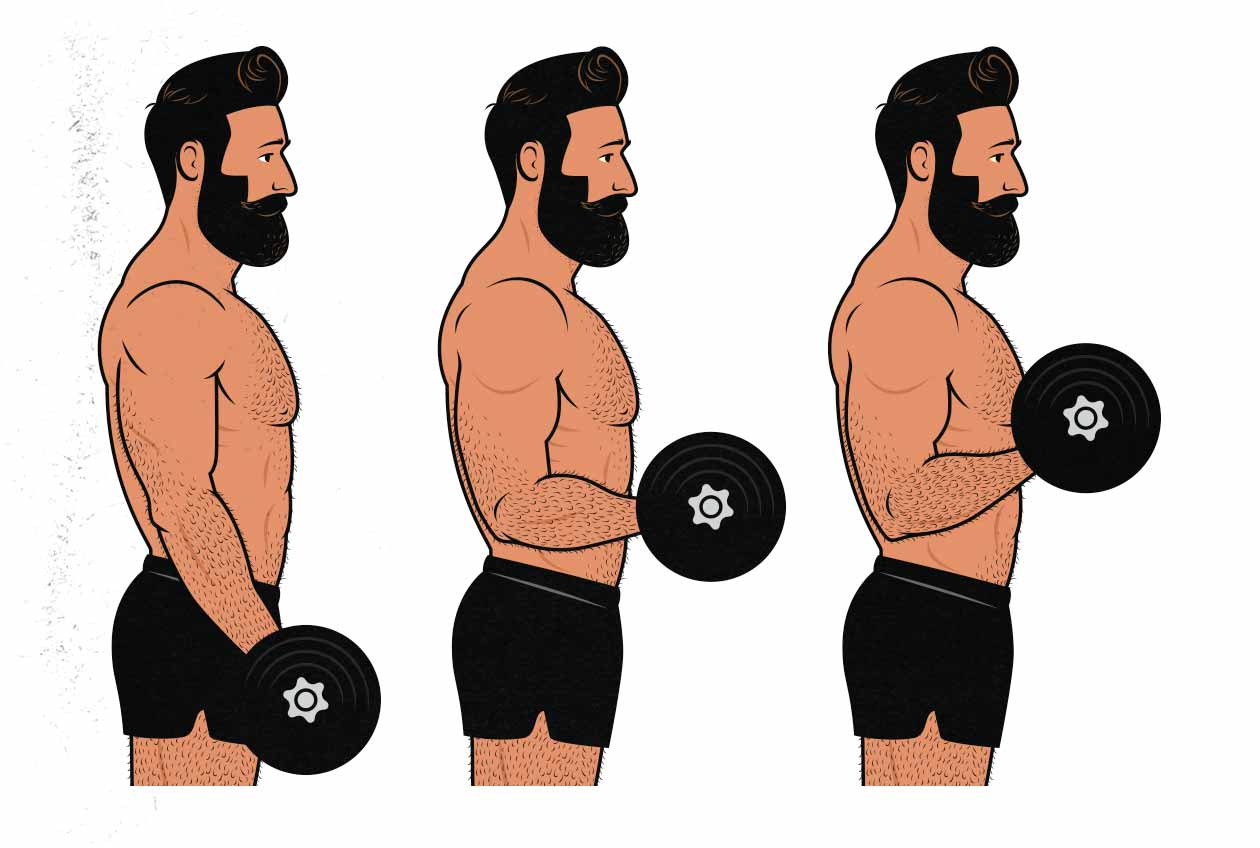
As a beginner, almost every lift will put some small amount of stress on your forearms muscles, which will be enough to stimulate a modest amount of muscle growth. Furthermore, since every lift requires forearm strength, if we do too much forearm training too soon, we can wind up with forearms that are too fatigued to allow us to do the rest of our lifts. As a result, beginners don’t need to jump right into forearm training, and oftentimes, it can do more harm than good. Better to wait a few months.
With that said, a good beginner routine will have a mix of compound and isolation lifts that stimulate almost all of the muscles in our bodies, forearms included:
- If you’re doing biceps curls, your forearm flexors will need to keep your wrist from bending backwards, which is often enough to stimulate a bit of forearm growth on the inside of your forearms.
- If you’re doing lateral raises, your wrist extensors will need to keep your wrist from bending forwards, which is enough to stimulate a bit of forearm growth along the backside of your forearms.
- If you’re doing rows or hammer curls, your elbow flexors will get quite a lot of stimulation, including the beefy forearm muscles up near your elbows.
- If you’re doing rows or Romanian deadlifts, your grip muscles will get quite a lot of stimulation, and that’s an important part of developing your forearms, but it won’t do much to help you build bigger forearms.
These aren’t the best forearm exercises, but they’re often enough to start making some progress. So if you’re a beginner following a good workout program, rest assured that your forearms are getting at least getting some stimulation. They may eventually start to lag behind, but that’s a problem you can address after gaining your first 10–20 pounds. That’s why we start including optional forearm training in our intermediate bulking program.
Beginners don’t need to do forearm exercises, especially since it might interfere with the rest of their training. Better to save it for the intermediate or advanced stage, and perhaps only during certain phases of training.
How to Train Your Forearm Muscles
Most of us assume that if we do our big compound exercises, our forearms will grow bigger in proportion to the rest of our muscles. Unfortunately, that’s not the case. Like our necks, without any direct training, many of our forearm muscles won’t be brought close to failure to stimulate much muscle growth.
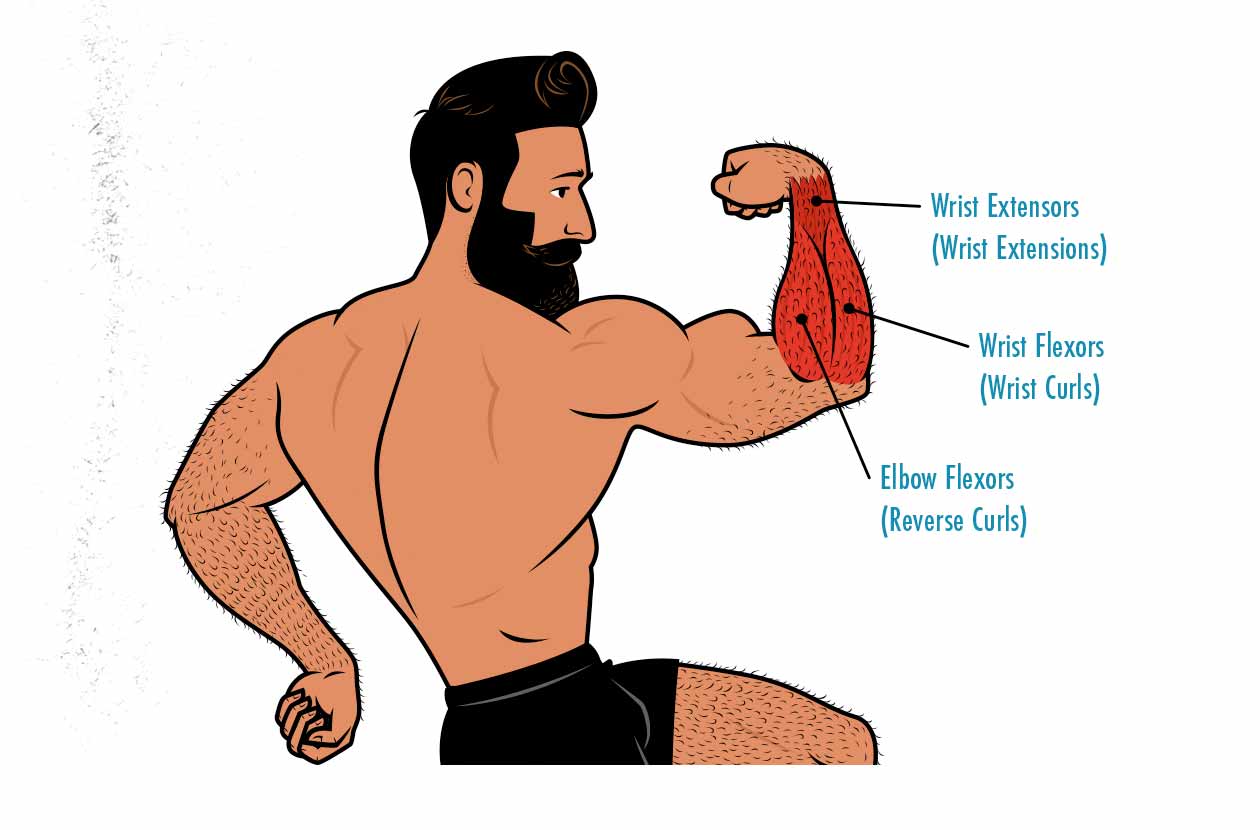
To bulk up our forearms, we need to train four different functions:
- Grip strength, such as with strapless deadlifts, and also with virtually every other heavy lift in our routines. To keep our hands nimble and dextrous, most of our grip muscles are located in our forearms. They aren’t very big, though, and won’t make our forearms much thicker.
- Elbow flexion, such as with barbell rows, pull-ups, and reverse curls. These muscles—our brachioradialis muscles—are quite big and have a large potential for growth. Most lifters with big forearms have big elbow flexors.
- Wrist flexion, such as with seated and standing wrist curls. The elbow flexors in our wrist are perhaps the biggest forearm muscles, and they have a huge carryover to our forearm aesthetics. Most guys who train for strength don’t train these directly, and so they often lag behind. It’s only bodybuilders, some athletes, and some people with manual labour jobs who tend to have thick wrist flexors.
- Wrist extension, such as with seated and standing wrist extensions. Almost nobody trains their wrist extensors, just like how most people don’t train the muscles on the fronts of their shins. These muscles are small, but they can indeed grow. For people with naturally thinner wrists or longer forearms, training the wrist extensors can help.
Those first two movements are trained with our compound exercises, so no worries there. And for guys with naturally thicker bones, naturally bigger forearms, or who work manual labour jobs, that may even be enough. But for people with naturally thinner bones, naturally longer forearms, or for those who truly want to push their shirt sleeves to their limits, we can also train our wrist flexors and extensors, which can make our forearms quite a bit thicker, stronger, and more muscular.
Our grip strength and elbow flexion can be trained with compound exercises, such as the barbell row, meaning that we don’t need to isolate those muscles unless we notice them lagging behind. Wrist flexion and extension aren’t fully trained by compound lifts, though, and so we can improve our forearm growth if we include dedicated forearm exercises in our workout routines.
Developing Your Grip for General Strength
Developing a stronger grip won’t do much to help us build bigger forearms, but even so, it’s still a crucial part of becoming big, strong, and healthy. People with stronger grips are more muscular (obviously), they look more attractive (study), and they even tend to live longer (study)! Now, no big surprises, there. Grip strength is a great proxy for general strength, and stronger people tend to be healthier, more attractive, and live longer.
If you have a weak grip, you won’t be able to hold much weight in your hands, and so you won’t be to work your other muscles very hard. With our Bony to Beastly and Bony to Bombshell programs, we help skinny beginners bulk up for the first time, and grip strength is a common bottleneck, especially on heavier lifts like rows and Romanian deadlifts. I had trouble with that too, and I remember wondering if I should be getting some sort of grip or forearm training device.
This specific type of strength—the strength needed to keep our hands closed around a barbell—is called support strength, which is different from the type of strength that we use while squeezing things (crushing strength). As a result, those grip squeezer things don’t tend to work very well. Better to stick with dumbbells and barbells.
The good news is that our grips naturally grow stronger as we get better at lifting weights. The muscles that limit your performance when lifting weights tend to see the most robust adaptations, and so during the periods of your training when your grip strength is holding you back, that’s also when your grip strength will see the fastest improvements. By the time you’re an intermediate lifter, your grip will be strong enough for almost any circumstance. And without ever needing to have done any dedicated grip or forearm exercises.
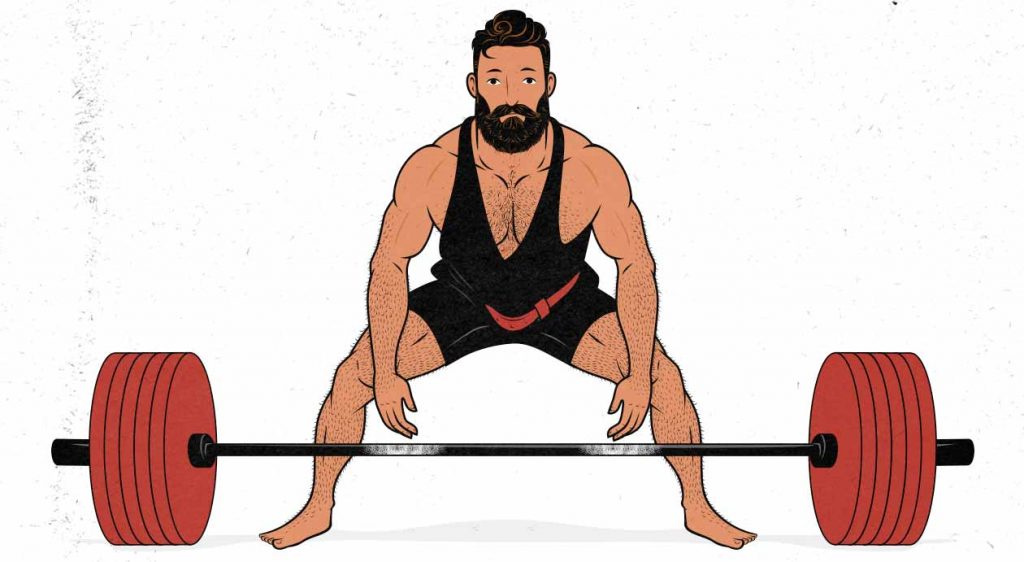
The one lift that tends to wreck our grips, though, even as seasoned lifters, is the deadlift. And when we’re deadlifting, we aren’t trying to do a convoluted grip exercise, we’re trying to train our entire posterior chains. So it’s important that you make sure that your grip isn’t holding you back. If that’s happening, there are a few forearm exercises you can do to improve your support strength:
- Follow a program that uses a variety of barbell lifts. Barbell rows, Romanian deadlifts, chin-ups, farmer carries, and curls will all help to strengthen your grip. If you have enough of these in your program, you probably won’t ever need dedicated grip training. But if your grip has fallen behind, it may pay to emphasize it for a bit. In my own case, as a beginner, I practiced a lot of dumbbell farmer carries. My grip was always the limiting factor, and so my grip strength exploded.
- Static holds. Once you’ve finished your heavy lifting for the day, load up a barbell and hold onto it for 15–30 seconds. Do 2–4 sets of these. Whenever you’re able to hold the bar for a good 30 seconds on the final set, add a bit more weight to the bar next workout. Use the same grip that you prefer while deadlifting (mixed or hook grip). Remember, we aren’t just trying to improve your general grip strength, we’re trying to improve your support strength when holding a barbell.
- One-armed static holds. If you want to mix in some core training with your grip training, you can train your grip one hand at a time. This is great for your obliques. You can do this with a dumbbell, a kettlebell, or a barbell that has centre knurling.
- Weighted hangs. If your back is fatigued from your heavy lifting, you might prefer to hang from a chin-up bar instead. It won’t be quite as specific, but it will allow you to train your grip without loading your spinal erectors, traps, or abs. Hold the bar for 15–30 seconds, adding weight when you can hold the bar for 30 seconds. And remember to do these at the very end of your workouts so that grip fatigue doesn’t interfere with your other exercises.
The trick is to grip a bar that has a similar diameter to the barbell that you’re deadlifting with. You can indeed emphasize your grip by using handles with a thicker diameter, but the strength that you gain won’t transfer over to the deadlift quite as well.
Lifting straps. You could, of course, avoid all of this hassle by using lifting straps, which is the approach taken by bodybuilders and strongmen. When you use lifting straps, you won’t be training your grip strength or forearms as much, but you’ll be able to work your target muscles harder—your traps, spinal erectors, lats, hips, and so on. We’ve got a full article on the pros and cons of lifting straps, as well as which ones are best.
Improving your grip strength probably won’t have a noticeable impact on your forearm size or aesthetics, but it’s an important part of becoming a strong person overall. Your grip strength is developed by compound lifts, but sometimes it can be a limiting factor, and that’s not always our goal. If your grip is holding you back, barbell holds, dumbbell holds, and bar hangs are the best exercises for making your grip stronger. Or you could lift with a mixed grip, hook grip, chalk, or lifting straps.
The 3 Best Forearm Exercises
The Best Brachioradialis Exercise: Reverse Curls
Now that we’ve talked about building a stronger grip to improve our general strength, let’s move on to the best exercises for building bigger forearms. The first muscle we want to target is the brachioradialis. People who including plenty of strapless barbell rowing in their routines often develop their brachioradialis just fine, but if you want to intentionally build bigger forearms, it can help to include some exercises that target them directly.
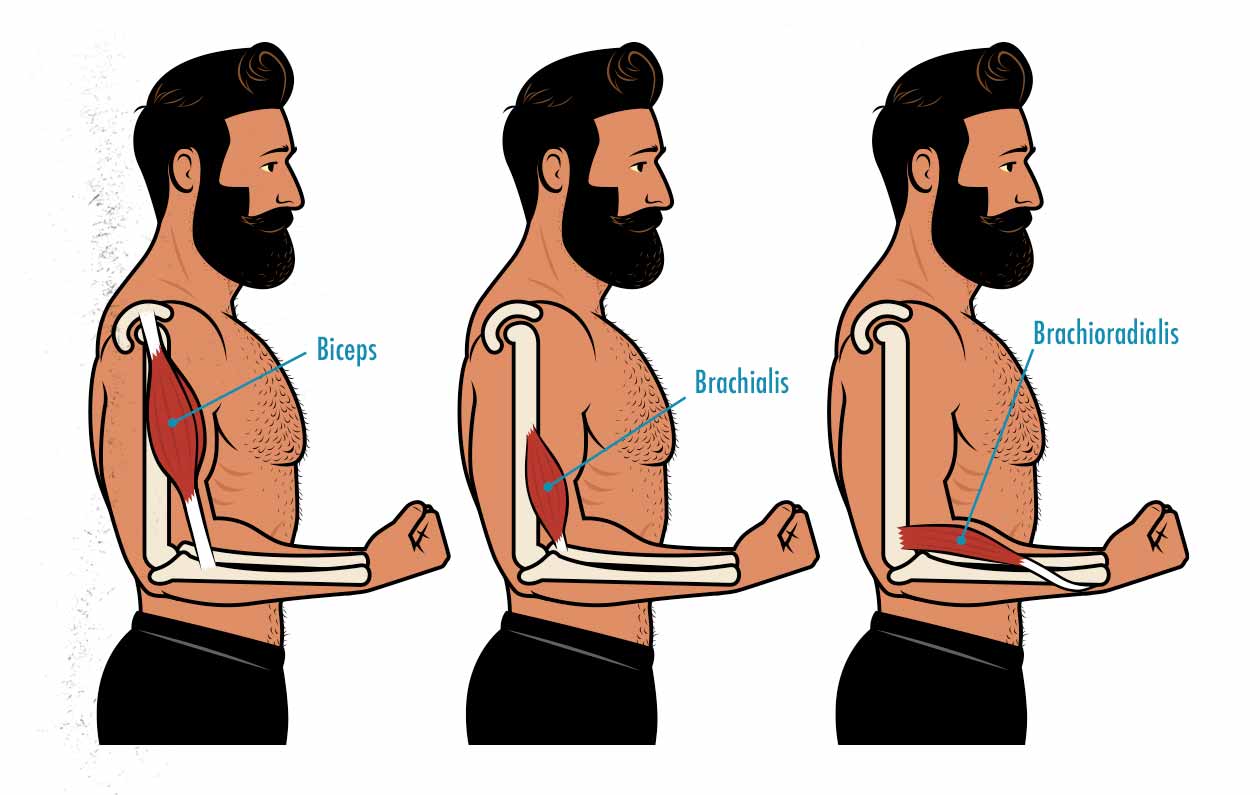
If we take a look at our elbow flexors, we see that our biceps, brachialis, and brachioradialis muscles can all help to flex our arms. If you look at how they attach to our forearms, though, you’ll notice something interesting. The muscles in our upper arms—the biceps and brachialis—both have a good line of pull when we use an underhand grip (as in the biceps curl and chin-up), whereas our brachioradialis muscles twists around to the back, giving us a better line of pull if we use an overhand grip. As a result, the best exercise for our brachioradialis is the reverse curl, like so:
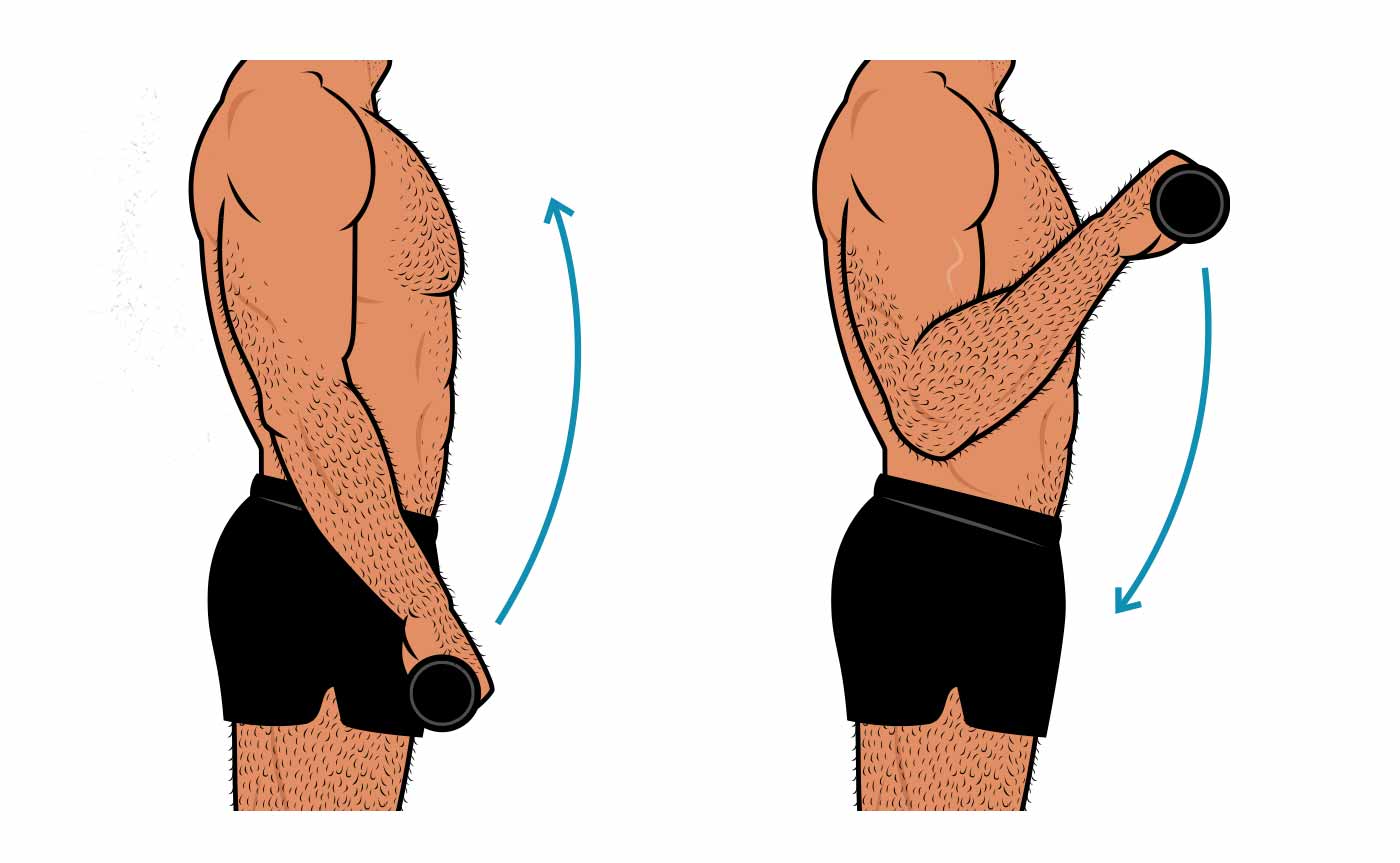
The reverse curl is best done with a curl-bar (aka EZ-Bar). Most gyms will have a few of these, often with fixed weights. Even if you use a home gym, these are a good barbell to invest in. They’re great for rows, curls, triceps extensions, and pullovers. But if you don’t have a curl-bar, you can always use dumbbells instead.

If the reverse curl makes your elbows or forearms hurt, no problem, that’s a common issue—try the hammer curl instead. Hammer curls use a mix of your brachialis and brachioradialis muscles, but they still do a good job of preventing our biceps from dominating the lift.
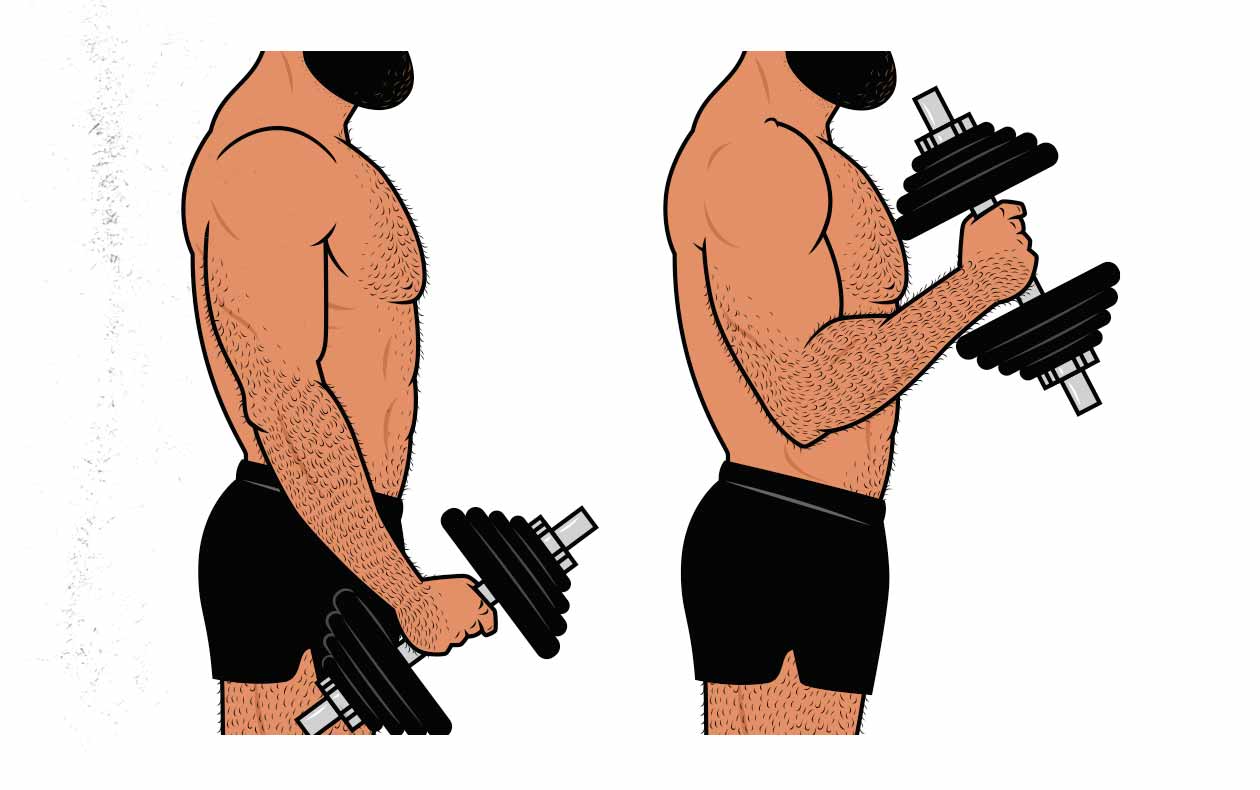
You don’t always need to include these exercises in your workout routine. You may not even need to include them in your forearm workout routine. Compound lifts are often enough to bulk these muscles up, and they’re certainly enough to maintain their size. But if you ever want to gain some extra size in your brachioradialis, reverse curls and hammer curls are great forearm exercises.
Our brachioradialis muscles are trained by compound exercises, such as overhand pull-ups and barbell rows, but if you want to isolate them, you can do reverse curls and/or hammer curls.
The Best Wrist Flexor Exercise: Wrist Curls
With most of these other lifts, there are caveats—”you might not need these” or “the growth potential isn’t that impressive” and so on. That’s not the case here. Wrist curls are the burning heart of forearm training. If you only do one forearm exercise, do this one. It works your wrist flexors, the beefy muscles on the inside of your forearms. You can think of them like the biceps of your forearms.
Your wrist flexors aren’t trained well with compound lifts, meaning that they’re often underdeveloped. When you start training them directly, they’ll explode into growth. These muscles are big, too, and are capable of adding inches to your forearm circumference.
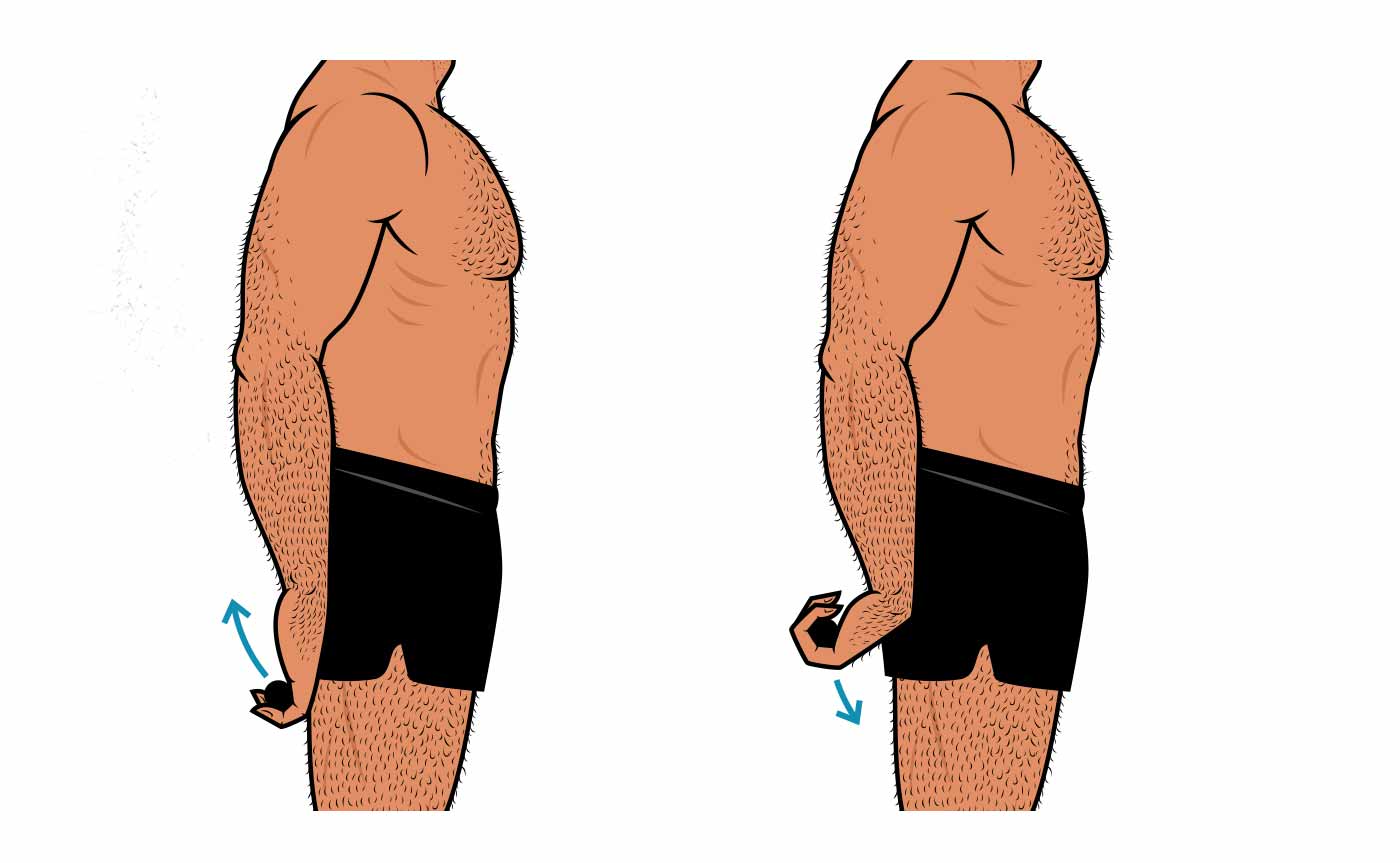
There are a couple popular ways of doing wrist curls. The first way is to do them standing, which works our wrist flexors at shorter muscle lengths and allows for a stronger peak contraction. However, as we’ve covered before, our muscles grow best when we challenge them in a stretched position (meta-analysis). So we don’t really want to be emphasizing the peak contraction, we want to be finding an exercise that challenges our wrist flexors at longer muscle lengths. That’s where the seated wrist curl comes in.
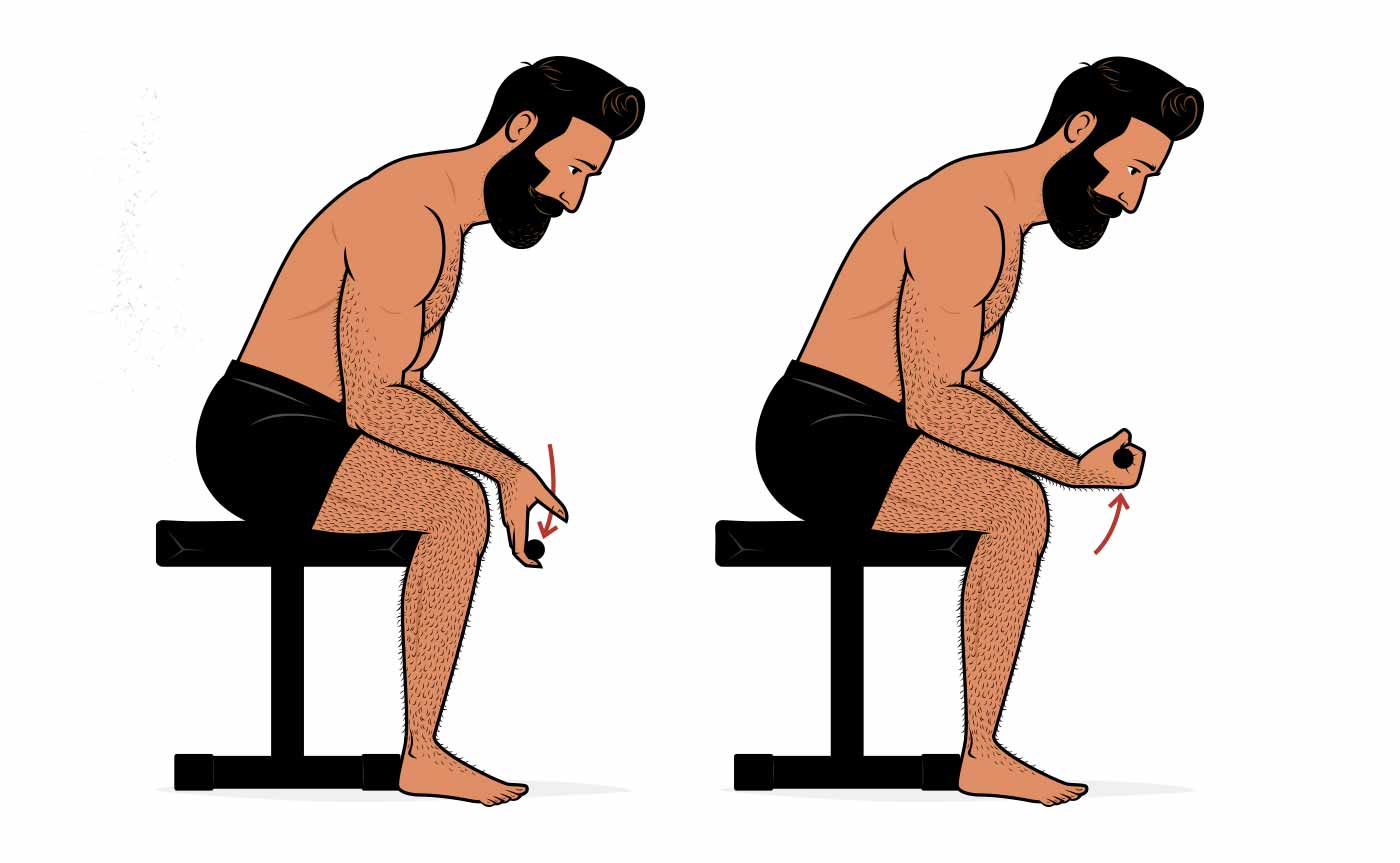
With the seated wrist curl, we’re giving our forearm muscles a nice stretch at the bottom of the lift, working them through a much deeper range of motion. This should, in theory, make them the better exercise for building bigger forearms. The only downside is that some people find them hard on their wrists. If that’s the case for you, no problem, you can always do your wrist curls from a standing position instead.
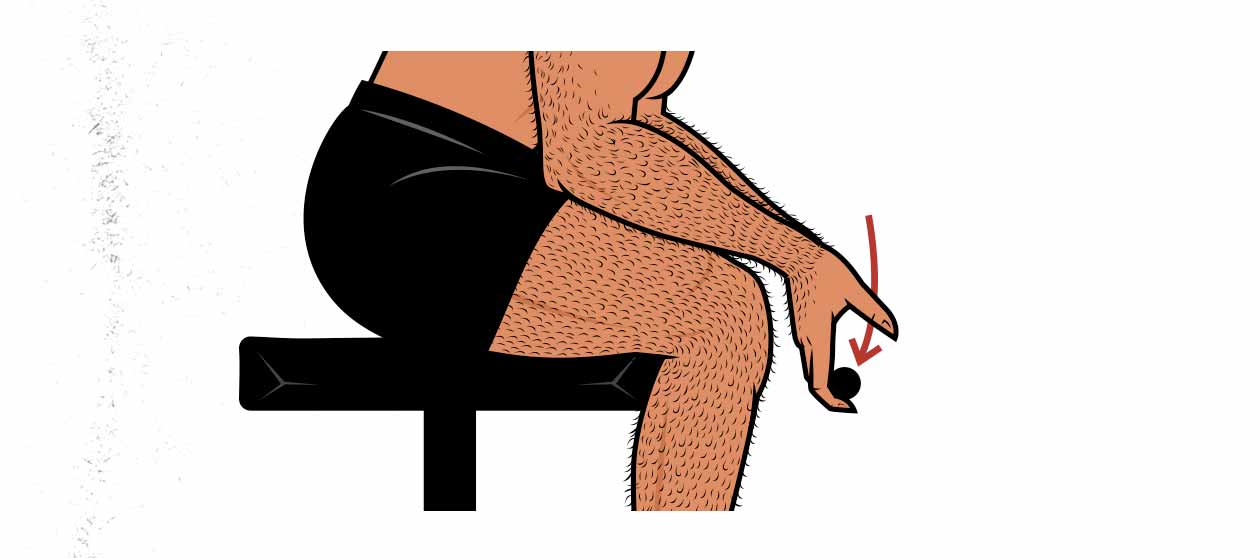
Now, the next part of working our forearm muscles through a deep range of motion is in the fingers. This is where most beginners go wrong, and you’ll even see a lot of people making this mistake in tutorial videos. Notice how in this illustration here, we’re opening our hands at the bottom of the range of motion. We’re rolling the barbell down into the crook of our fingers. This gives our forearm muscles an even deeper stretch, allowing us to stimulate extra muscle growth. And even though it looks a bit awkward, you’ll notice that it makes the exercise feel much better, as it allows you to feel a nice, deep stretch at the bottom. And this huge range of motion with an added stretch is what makes the wrist curl such a powerful forearm exercise.
The wrist curl is the single best exercise for building bigger forearms. Our wrist flexors are big, they have a good potential for growth, and wrist curls are the best way to work them hard through a large effective range of motion. The best type of wrist curl is the seated wrist curl, but if they hurt your wrists, try doing them standing instead.
The Best Wrist Extensor Exercise: Wrist Extensions
Have you ever seen anyone doing calf curls? Not calf raises, which are popular with bodybuilders, but calf curls? Probably not. That’s because the muscles that run along the fronts of our shins aren’t very big and don’t have a big impact on our general strength. The same is true with our wrist extensors. These are smaller muscles that only factor into a couple of more minor lifts. If you’re doing reverse curls or lateral raises, your wrist extensors will hold your wrists straight. Beyond that, though, they aren’t really trained, and so they’re often somewhat underdeveloped.
Should we train our wrist extensors? That really depends. These are the muscles that run along the back sides of your forearms, from your elbows all the way down to your wrists. If you have naturally thinner wrists or longer forearms, building these muscles even just a bit bigger will make your forearms look quite a bit thicker overall. They won’t necessarily make the bony protuberance at your wrist thicker, but they’ll certainly make that general area more muscular.

If you decide to train your wrist extensors, the best exercise is the wrist extension. You can do it with a barbell, an EZ-Bar, kettlebells, or dumbbells. Whatever you use, your thumb will need to bear the weight, and your thumb probably isn’t very strong, so you’ll probably find it difficult at first. It helps to use lighter weights and higher reps, aiming for as many as 20–30 reps per set..
Wrist extensions train the smaller, longer muscles that run up along the back sides of your forearms. Most people don’t train them, but you can, and they will grow. They won’t grow enormous, but they can indeed grow significantly bigger, making the entire length of your forearms thicker and more muscular. As a result, wrist extensions earn their spot as one of the three best forearm exercises.
The Best Forearm Workout
Forearm training is fairly simple. All we need are three forearm exercises, one for each movement that our forearms help us with: elbow flexion, wrist flexion, and wrist extension. And since our forearm muscles are relatively small, we can blast through these exercises fairly quickly. We don’t need much rest time between sets, they aren’t very tiring, and they’re easy to recover from.
Building bigger forearms, then, can be as simple as doing three forearm exercises three time per week. You could do them on your rest days, or you could tack them onto the ends of your regular workouts.
Here’s a sample forearm workout:
- Reverse Curls: 2–3 sets of 10–15 reps.
- Seated Wrist Curls: 2–4 sets of 12–20 reps
- Seated Wrist Extensions: 2–3 sets of 15–30 reps
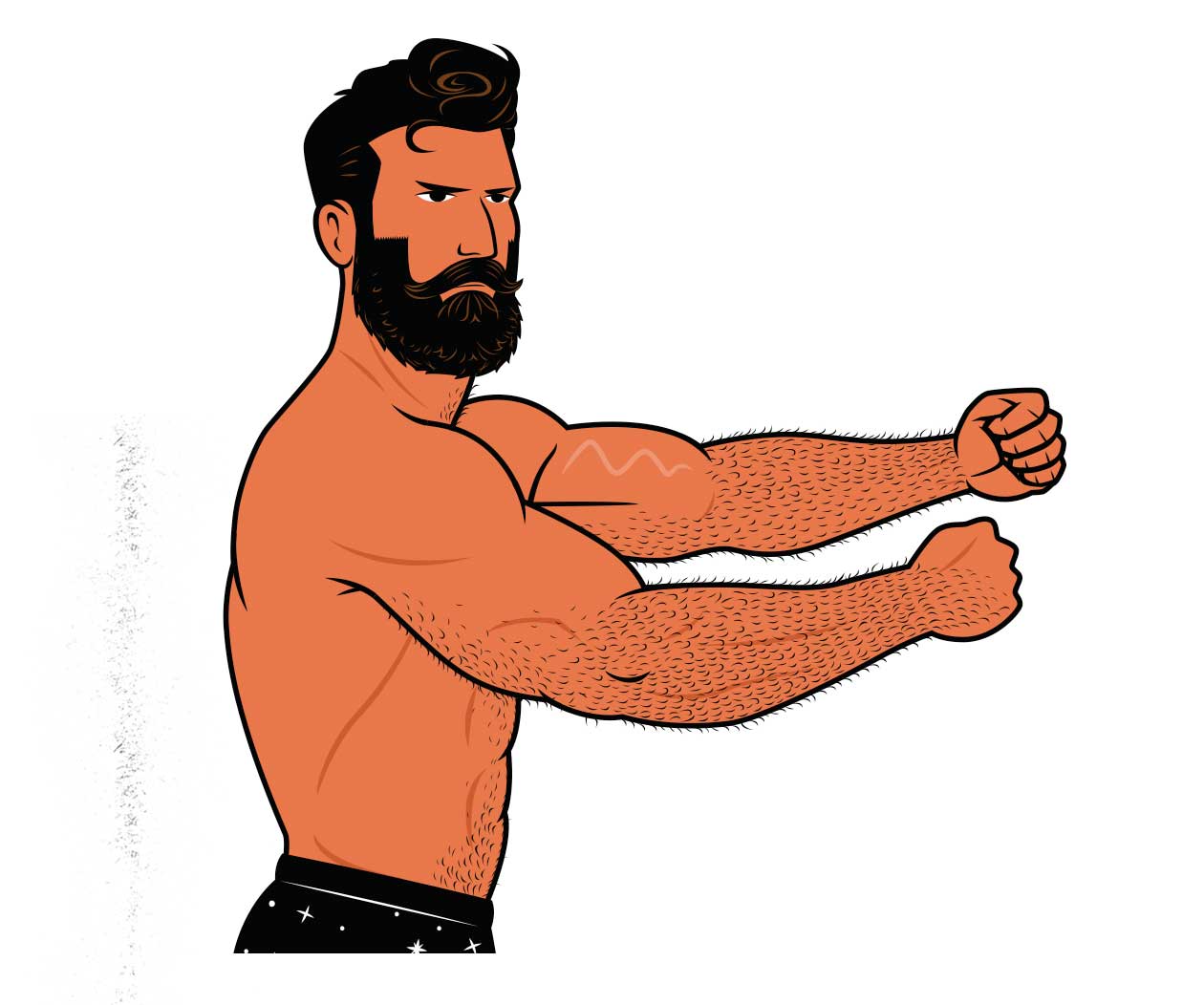
Forearm exercises burn with the fury of the deepest level of Hell, especially since you’re lifting in higher rep ranges, but don’t let that stop you. Grit your teeth, and take every set within a rep or so of muscle failure. When you get your target reps on your final set, add a bit of weight. Remember, your forearms will grow in proportion to your strength, so keep fighting to get stronger at these lifts. Every workout, try to outlift yourself.
If you want to make these forearm workouts even shorter, feel free to use drop sets instead of straight sets. For example, do a set of wrist curls with 95 pounds, strip off 30 pounds, and then, without resting, do a second set with 65 pounds. Then strip off another 20 pounds, and do a third set with 45 pounds. You might stimulate slightly less growth, but it should still be enough to make great progress.
Every month, feel free to switch these forearm exercises out for slightly different variations. Try standing wrist curls and extensions instead of seated wrist curls. Try hammer curls instead of reverse curls. That extra variety will give your joints a break. And by challenging your muscles in slightly different ways, the new exercises may also stimulate a new wave of forearm growth.
After doing these forearm workouts for a couple of months, feel free to ease back on your forearm training for a few months. Your compound lifts should be enough to maintain your forearm size, so don’t fall into the trap of thinking that you always need to be doing forearm training. Barbell rows (or overhand pull-ups) should be enough to maintain your elbow flexors, biceps curls should be enough to maintain your wrist flexors, and lateral raises should be enough to maintain your wrist extensors.
Summary
Compound exercises are often enough to train our grip strength and brachioradialis muscles, and that’s certainly part of building bigger forearms. But our wrist flexors and wrist extensors will often lag behind. To build bigger forearms, then, it helps to target them directly. The three best exercises for that are the reverse curl, wrist curl, and wrist extension. You can build an entire forearm workout around just those three exercises.
For newer lifters, grip and forearm strength are often limiting factors already, and it’s easy for the big barbell lifts to beat up our hands. During that phase of your training, direct forearm isolation exercises can interfere with the rest of your workout routine, and so it’s usually best to save the forearm isolation exercises for later. For intermediate lifters, it’s usually fine to add some forearm exercises to the ends of your workouts or to do separate forearm workouts on rest days. It won’t interfere with your regular workouts, and it’s an incredibly effective way to bulk up your forearms.
When training your forearms, doing moderate-to-high reps tends to work best, aiming for 12–30 reps per set, and 2–4 sets per exercise. Our cardiovascular performance or overall fatigue won’t ever be an issue, so feel free to use shorter rest times or drop sets to speed up your forearm workouts.

As always, if you want a customizable workout program (and full guide) that builds these principles in, check out our Outlift Intermediate Bulking Program. We also have our Bony to Beastly (men’s) program and Bony to Bombshell (women’s) program for skinny beginners. If you liked this article, you’ll love our full programs.




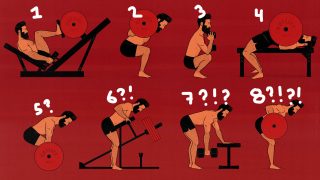
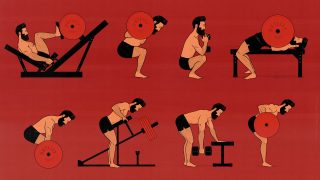
I have lagging forearms. Over the past 6 months, my arms grew by nearly 3 inches, my shoulders by 4-5 inches, and so on while my forearms grew by just 1 inch and is the most underdeveloped part of my physique. I do about 16 sets of direct forearm isolation work. I even tried implementing a stretch in my wrist and reverse curls but hasn’t really helped much. What could I do? By the way, I’m 15.
Hey man, that’s actually not so bad! If your forearms are growing, they’re growing. They’ll never grow as big or as fast as your upper arms, but that’s okay. They don’t need to get as big, either.
Practically speaking, though, you could do your forearm exercises earlier in the workout and do more sets. That way you’re giving them your time and energy, similar to how you’d work on your bigger muscles.
I already do forearm exercises early in the workout and especially over the last 3 months, they have not grown. Would more frequent training, higher volume or something of that source help.
Yeah, you can try higher volume for sure. Make sure you’re using progressive overload, too, fighting to add weight or reps from week to week.
But remember that it IS working. Your forearms ARE growing.